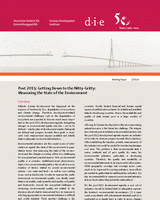Post 2015: getting down to the nitty-gritty: measuring the state of the environment
Stepping, Katharina M.K.Briefing Paper 5/2014
Bonn: German Development Institute / Deutsches Institut für Entwicklungspolitik (DIE)
Hitherto human development has happened at the expense of biodiversity loss, degradation of ecosystems and climate change. Therefore, development-related environmental challenges such as the degradation of ecosystems are expected to become much more important in the post-2015 development agenda. Integrating changes in environmental quality into the – yet to be defined – master plan of development implies that goals are defined and progress towards these goals is measured. Such measurement requires available and reliable data on adequate environmental indicators.
Environmental indicators are the crucial source of information as regards the state of the environment in quantitative terms. But measuring the state of the environment and the changes occurring within it is challenging for conceptual and practical reasons: first, environmental quality is a complex, multidimensional phenomenon. High or low environmental quality is the result of a combination of factors related to several environmental spheres – air, water and land – as well as cross-cutting issues such as biodiversity. In order to measure the multidimensional environmental quality, one ideally needs data on air quality, water quantity and quality, soil quality and biodiversity. Second, the conceptual challenges of measuring environmental quality are related to the decisions about what to measure and how to measure it; selecting appropriate environmental indicators is difficult and vividly debated. Third, another challenge is the selection of indicators that are adequate for both the situation in developed as well as developing countries. Fourth, limited financial and human capital represents additional constraints for reliable and available data for developing countries. Hence, the availability and quality of data remain poor in a large number of countries.
Allowing for human development without compromising natural resources is the future key challenge. The integration of development-related environmental objectives into the post-2015 development agenda requires an indicator set in order to measure progress towards these objectives. After establishing the baseline, periodic measurements of the indicator set would be needed for monitoring damages over time. The problem is that environmental data is scarce, scattered and of poor quality for many key environmental indicators, particularly in developing countries. Therefore, the quality and availability of environmental data needs to be improved for all countries. While geographic coverage and coverage across years needs to be improved for existing indicators, more efforts are needed to gather data for additional key indicators. It is also recommendable to measure environmental indicators at lower levels rather than just at the national level. For the post-2015 development agenda, a core set of indicators should be defined that (1) adequately captures the location’s environmental circumstances, (2) is measured concordantly with international standards and (3) is conducted on a regular basis in order to assess changes over time. This also requires investments in know-how and infrastructure for data gathering and data processing.


